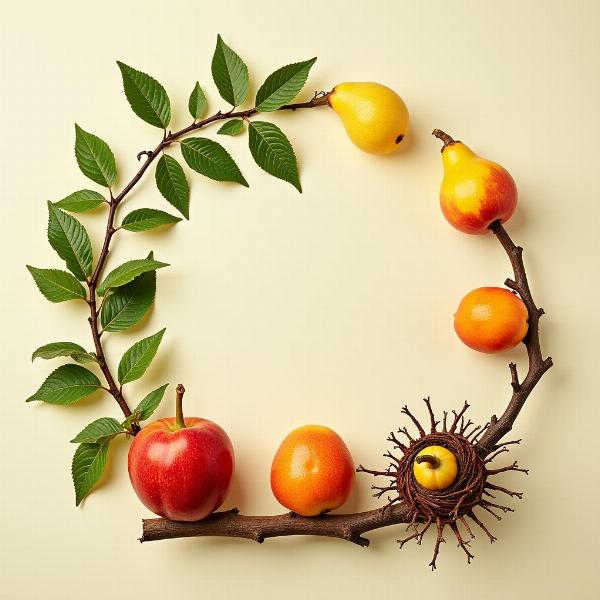Understanding the concept of ripeness is crucial in a country like India, where fresh produce plays a central role in daily life. The Hindi word for “ripeness” often translates to “pakka” (पक्का), but this simple translation doesn’t fully capture the nuances and cultural significance associated with the term. This article will explore the various meanings of ripeness in Hindi, its connection to Indian culture, and how it affects daily life, from selecting fruits and vegetables in the market to appreciating the symbolism of ripeness in literature and tradition. What does “pakka” truly mean in different contexts? Let’s delve into the rich world of Hindi and explore the depths of this seemingly simple word.
The Core Meaning of “Pakka” (पक्का)
“Pakka” (पक्का) is the most common Hindi word for “ripe,” and it’s widely used to describe fruits and vegetables that have reached their peak state of maturity and flavor. A “pakka aam” (पक्का आम) is a ripe mango, a “pakki kela” (पक्की केला) is a ripe banana, and “pakke tamatar” (पक्के टमाटर) are ripe tomatoes. The term indicates that the produce is ready to be eaten, offering the best taste and texture. However, “pakka” can also imply a sense of completeness or certainty. For instance, “pakka khabar” (पक्का खबर) means confirmed news, while “pakka dost” (पक्का दोस्त) refers to a true friend.
Beyond “Pakka”: Other Words for Ripeness in Hindi
While “pakka” is widely understood, Hindi offers a rich vocabulary with more specific terms to describe different stages of ripeness. “Pura pakka” (पूरा पक्का) emphasizes complete ripeness, often suggesting a slightly softer texture. “Adhpakka” (अधपक्का) refers to something half-ripe, suitable for pickling or cooking, but not ideal for eating raw. “Kacha” (कच्चा), the opposite of “pakka,” denotes unripe or raw. Understanding these nuances is essential for navigating the bustling Indian markets and selecting the perfect produce for your needs.
Ripeness and Indian Cuisine
Ripeness plays a critical role in Indian cuisine. The choice between a “kacha aam” for chutney and a “pakka aam” for dessert transforms the flavor profile entirely. Ripeness dictates the use of specific ingredients in various dishes, highlighting the intricate relationship between language, food, and culture. “Pakka kela” is perfect for sweet dishes, while “kacha kela” finds its way into savory curries. This understanding of ripeness is passed down through generations, making it an integral part of Indian culinary heritage.
Cultural Significance of Ripeness
Ripeness in Hindi goes beyond culinary applications. It symbolizes completion, maturity, and the fulfillment of potential. In literature and folklore, ripeness often signifies a stage of life, a moment of realization, or the attainment of wisdom. The ripeness of a fruit can be a metaphor for the journey of life, reminding us of the cyclical nature of growth, decay, and renewal.
 The Cycle of Ripeness: A Metaphor for Life
The Cycle of Ripeness: A Metaphor for Life
What is the meaning of “Pakka” in relationships?
In interpersonal relationships, “pakka” can signify a deep, unwavering bond. A “pakka dost” is a true friend, someone you can rely on. It indicates a strong commitment and trustworthiness.
What does “Pakka ghar” mean?
“Pakka ghar” (पक्का घर) refers to a house made of durable materials like brick and cement, as opposed to a “kacha ghar” (कच्चा घर) made of mud or temporary materials. It symbolizes permanence, stability, and a sense of belonging.
Conclusion
The word “ripeness” in Hindi, primarily represented by “pakka” (पक्का), is far more than a simple descriptor of fruit. It’s a word interwoven with the fabric of Indian culture, reflecting not just the culinary practices but also the philosophical and symbolic understanding of life’s journey. From the selection of ingredients in the kitchen to the understanding of human relationships, the concept of “pakka” permeates everyday life in India.
FAQ
- What’s the difference between “pakka” and “pura pakka”? While both mean “ripe,” “pura pakka” emphasizes complete ripeness, often implying a softer texture.
- Is there a word for “overripe” in Hindi? Yes, “sada hua” (सड़ा हुआ) refers to overripe or rotten fruit.
- How is ripeness determined in Indian markets? Vendors often rely on touch, smell, and visual cues to determine ripeness.
- What is the antonym of “pakka”? “Kacha” (कच्चा) is the antonym of “pakka,” meaning unripe or raw.
- Can “pakka” be used metaphorically? Yes, “pakka” can symbolize maturity, completion, and certainty in various contexts.
- What does “pakka irada” mean? “Pakka irada” (पक्का इरादा) means firm intention or resolve.
- How does ripeness affect the taste of fruits? Ripeness brings out the full flavor and sweetness of fruits.
Meaning-Hindi.in offers expert translation services specializing in Hindi and other languages, covering various domains, including business, legal, technical, website localization, educational, and specialized fields. Our team ensures accurate, culturally sensitive, and engaging content. Whether you need to translate business documents, legal contracts, technical manuals, or educational materials, we provide high-quality translations tailored to your needs. Contact us for accurate and reliable translation services: Email: [email protected], Phone: +91 11-4502-7584. Meaning-Hindi.in is your trusted partner for all your translation requirements.